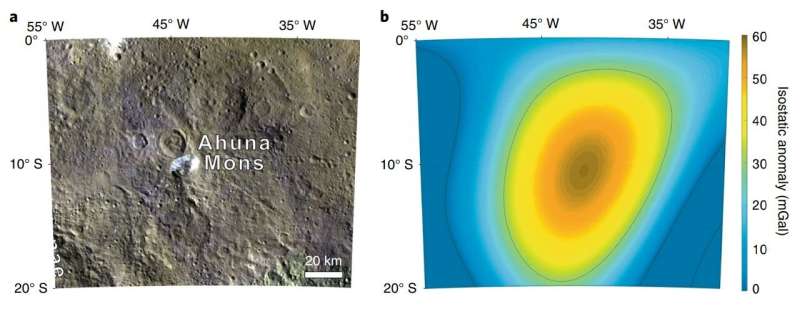June 11, 2019 report
Gravitational data from Dawn suggests dome on Ceres is made of volcanic mud

An international team of researchers has found evidence that suggests the large dome found on the surface of the dwarf planet Ceres is made of slurry—a mix of salty brine and solid particles. In their paper published in the journal Nature Geoscience, the group describes their study of data from the Dawn spacecraft and what it revealed.
Back in 2015, NASA's Dawn space probe showed that there was a domed-shaped mountain approximately four kilometers high and seventeen kilometers wide—since named Ahuna Mons—rising from the surface of Ceres, a dwarf planet residing in our solar system's asteroid belt. Initial inspection suggested volcanism; the dome-shape streaked mountain with salt on its slope looked reminiscent of volcanoes here on Earth, or even the icy domes seen on some of the solar system's moons. But logic has suggested that the mechanics involved in creating volcanism on a dwarf planet would not work. Because of its small size, it would cool down and solidify, preventing any interior activity. But that logic appears not to apply to Ceres, the team found.
The researchers noted evidence that the dome was created relatively recently, perhaps just a couple hundred million years ago—it has very few craters. Also, prior study of data from Dawn by another team led to the discovery that Ceres had a mantle loaded with fluids. To learn more, the team looked at gravity field maps built using data from Dawn. They found evidence of a plume extending from the mantle to the dome above it. A closer look suggested that the plume had at some point carried a mud-like mix of water, salt and other particles up into the area where the dome had formed.
The researchers describe the plume as unlike any other documented to date, and thus is a novelty in the solar system. They also note that because of the composition of the plume, there is a possibility that Ceres' mantle is still churning, pushing material up into the dome making it grow.
More information: Ottaviano Ruesch et al. Slurry extrusion on Ceres from a convective mud-bearing mantle, Nature Geoscience (2019). DOI: 10.1038/s41561-019-0378-7
Journal information: Nature Geoscience
© 2019 Science X Network





















